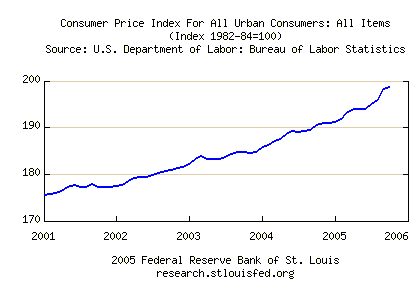

|
| weblog/wEssays | home | |
|
Worried About Dollar Inflation? Just Stop Measuring It (December 1, 2005)  More than a few eyebrows arched in dismay when the Federal Reserve recently announced
that it would no longer calculate the broadest measurement of money supply in our economy,
M3: for example,
"Fed abandons M3 measure of money supply."
More than a few eyebrows arched in dismay when the Federal Reserve recently announced
that it would no longer calculate the broadest measurement of money supply in our economy,
M3: for example,
"Fed abandons M3 measure of money supply."
More than a few observers reckoned that the dismissal of M3 had less to do with the stated reasons--to save money in data-crunching and because M3 was judged to be inferior to M2--than the government's desire to obscure real US dollar inflation. To quote from the first linked article: here is the Fed's stated reason for dropping M3, and the writer's rsponse: "M3 does not appear to convey any additional information about economic activity that is not already embodied in the M2 aggregate. The role of M3 in the policy process has diminished greatly over time. Consequently, the costs of collecting the data and publishing M3 now appear to outweigh the benefits."As this chart reveals, inflation has been rising inexorably for the past two years; in response, the Fed has been inexorably clicking the Fed Funds interest rates up from 1% to 4%. If you glance at this chart posted on the Federal Reserve website, you'll note that 4% is historically still rather low; at the start of 2001, the rate was 6%; from 1994 through 2000, the rate was above 5%. Stock market pundits are nearly hyper-ventilating at the prospect that the Fed will stop raising interest rates, for such as move would vigorously goose stock prices. But if you look at this graph of inflation, and consider the recent historical average of about 5%, then you wonder if the pundits should reach for their tranquilizer of choice. For there is little reason for the Fed to stop raising rates, and a very critical reason to keep pushing them back to 5%--rip-roaring inflation. To quote Briefing.com's Nov. 30 afternoon summary: The November Chicago PMI report revealed that manufacturing trends remain strong, but the market perhaps focused upon the price-paid portion, which rose 18% and to its highest level in over 25 years.While it may well be that M3 measurement of money supply is no longer quite as accurate as it might be, wouldn't the prudent reaction be to tweak the data sources to improve the accuracy? It is more than suspicious that the Fed decides instead to ax the financial measurement which best captures the enormous expansion of money in our economy. * * * copyright © 2005 Charles Hugh Smith. All rights reserved in all media. I would be honored if you linked this wEssay to your site, or printed a copy for your own use. * * * |
||
| weblog/wEssays | home |